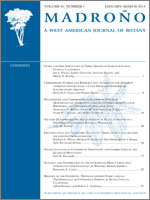At the beginning of the 21st Century, deserts and woodlands of the southwestern United States were in the midst of a drought that contributed to massive die-offs for many plant species. In the northwestern Sonoran Desert, the drought contributed to extreme desiccation and mortality of cholla (Cylindropuntia) cacti. At low elevations (210–290 m), over half of the Cylindropuntia bigelovii, over 17% of the C. echinocarpa, 6% of the C. ramosissima, and less than 2% of the C. ganderi were dead by winter 2004/2005. At a higher elevation (∼820 m), 26% of C. bigelovii and 14% of C. ganderi were dead by winter 2005/2006. The lower mortality for C. bigelovii at the higher elevation site was likely due to milder temperatures and greater precipitation; the greater mortality for C. ganderi at the same site may be the result of freezing or frost damage to tissues during the drought. Differences in mortality among species at both elevations were attributed to several factors, including: intra- and interspecific competition, reproductive strategy, and shoot architecture. Based on this study and previous research, it is believed that C. bigelovii experiences periodic extensive die-offs in response to extreme droughts, whereas populations of the other three species apparently change little during such droughts.
How to translate text using browser tools
1 January 2014
Cholla Mortality and Extreme Drought In the Sonoran Desert
Edward G. Bobich,
Nick L. Wallace,
Keely L. Sartori
ACCESS THE FULL ARTICLE

Madroño
Vol. 61 • No. 1
January 2014
Vol. 61 • No. 1
January 2014
Chollas
Cylindropuntia
desert
drought
mortality




